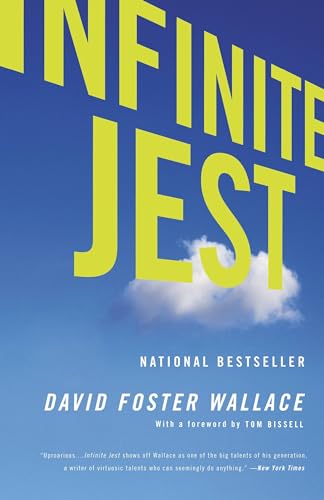Hey there, readers! Fancy a deep, chaotic dive into some mind-bending storytelling with a side of dark humor? You’re in the right place for a review of Infinite Jest. Grab your tennis racket—or, well, just your reading glasses—and get ready for a wild ride! The book’s like trying to juggle while riding a unicycle. Yet somehow, it still makes total sense. As I weave through the complex plot, unique character developments, and spot-on social commentary—you’ll see why this novel keeps readers engaged and scratching their heads. Stick around; it’s going to be a journey worth taking!
Review of ‘Infinite Jest’ by David Foster Wallace
In a nutshell
Infinite Jest, written by the brilliant David Foster Wallace, is a rollercoaster ride through the realms of satire and speculative fiction. The book offers an intricate tapestry that combines dark humor with biting social commentary.
In this hefty tome, Wallace explores themes of addiction, entertainment, and the pursuit of happiness in a way that is both absurd and painfully relatable. The story is set in a dystopian future where a mysterious film has chaotic effects on viewers. Characters are richly developed, and the plot, while complex and non-linear, is immensely rewarding for those who stick with it.
This novel is perfect for readers who appreciate a challenge, enjoy unraveling layers of storytelling, and have a taste for both wit and intellectual depth.
Untangling the Web: The Complex Plot and Structure of Infinite Jest
Picture this: my friends and I gathered at a coffee shop, Infinite Jest in hand, ready to unravel its mind-bending plot. We knew we were in for a ride, because boy, does David Foster Wallace know how to weave a complex tapestry!
Now, if you enjoy a linear storyline, Infinite Jest might not be your cup of tea. Imagine walking into a maze with no map, and you’ve got the gist of this book. Wallace zigzags between different characters, timelines, and locations with a seemingly reckless abandon that, surprisingly enough, works beautifully.
The story intertwines the lives of the Incandenza family, residents and staff of a tennis academy and a rehabilitation center. It feels like you’ve landed in the middle of a three-ring circus, but my friends and I came to love each and every act. The intricate plot demands patience, as it tests your mental gymnastics by flipping through sections like a TV remote.
Wallace’s genius lies in how he orchestrates this chaos. The narrative, sort of like cooking a complex dish, reveals its flavors gradually. My friends can confirm: the effort pays off! However, the downside is that Infinite Jest can be overwhelming, especially for those who prefer straightforward tales. It’s like playing chess with your brain while juggling flaming swords—you might drop one!
Despite its hurdles, I found the book fascinating for its depth and structure. It’s not for everyone, but if you love a challenge, it’s worth it. Next up, let’s talk about how Wallace delves into social commentary and themes—like a rollercoaster into the human psyche!
Social Commentary and Themes in Infinite Jest
When I began my journey with Infinite Jest, I knew I’d be hanging out in a world filled with more layers than my grandma’s lasagna. David Foster Wallace assembles a feast of social commentary and themes, leaving you munching on thoughts long after you’ve closed the book. Trust me, this book’s got stuff that sticks to your ribs.
Wallace has a gift for portraying the absurdity of life. He skewers modern consumerism with wit sharper than a porcupine in a balloon shop. Infinite Jest sets itself in a peculiar future where entertainment and consumer products have reached bizarre peaks. The book paints a world hilariously and terrifyingly similar to our own, forcing a chuckle and a cringe simultaneously. Did I laugh while reading? Absolutely. Did I also vow to stop binge-watching TV shows for a week? Definitely.
Another theme that clings onto your mind like an over-eager dog is addiction. Whether it’s drugs, entertainment, or validation, Wallace sheds light on human vulnerabilities. His portrayal isn’t preachy. It’s raw, it’s honest, and it made me reflect on my own guilty pleasures. You might find yourself saying, “Well, that’s a little too real, Dave.”
Underlying all the satire is Wallace’s deeper message about finding genuine human connections in a world drowning in distractions. It’s a reminder to unplug and engage with the world around us. But hey, I’ll stop before I sound like your old high school counselor.
With these captivating themes fresh in your mind, prepare to waltz into the next section, where Infinite Jest‘s unique character development takes the spotlight. Hang tight, folks!
Exceptional Character Development in Infinite Jest
David Foster Wallace crafts characters in Infinite Jest like they’re the quirky inhabitants of an amusement park. Each one’s unique, yet they all come together to tell a story that’s thoughtful and, well, sometimes just downright odd! Take Hal Incandenza, for example. Hal isn’t your typical teenager. He’s a tennis prodigy with a fondness for dictionaries. His journey might sound typical, but Wallace plays with his mind in a way that kept me flipping pages, coffee in hand, late into the night.
Then there’s Don Gately. Oh, Don! A former burglar turned rehab counselor. His character arc is a rollercoaster of redemption and self-discovery. I remember reading his early chapters and thinking, “Is he the good guy or the bad guy? Or just a guy trying to find his own peace?” Wallace’s ability to mold such multi-dimensional characters is thrilling. He weaves their lives into a tapestry that keeps you guessing and cheering.
And let’s not forget the Incandenza family. Mario’s innocence and marionette-like limp innocence offer a sharp contrast to the chaotic world around him. Each family member reflects existential struggles and human imperfections. I chuckled often at their interactions, reminded of family dinners where everyone talks, but nobody really listens. Such moments make the characters relatable, adding depth to their personal dilemmas.
Unique character development in Infinite Jest reminds me of why I love reading. It’s like meeting new friends who are as flawed as they are lovable. Stay tuned as I somersault into the humor and satire that Wallace so masterfully stitches into his story!
Humor and Satire in Infinite Jest: Laughing Through the Chaos
If you ever found yourself giggling at the absurdity of life, then Infinite Jest might just tickle your funny bone. David Foster Wallace didn’t just write a book; he penned a chaotic symphony of humor and satire that had me chuckling like a madman. You know, the kind of laugh where milk squirts out of your nose, even if you’re not drinking any at the time.
The humor in Infinite Jest is like a slapstick comedy set in a world gone bonkers. I remember rolling on the floor when I got to the Eschaton scene. It’s like an overly complex game of Risk being run by a group of kids who take it way too seriously. I once tried getting my friends to play Eschaton with the same fervor…let’s just say the day ended in tears and not the joyful kind.
Wallace uses satire not just to entertain but to critique societal issues. He pokes fun at addiction and media culture, making you laugh and cringe at the same time. It’s like watching a stand-up comedian who knows your deepest secrets and calls you out on them. His jokes hit hard because they’re not just jokes – they’re uncomfortable truths about us.
So, would I recommend this epic piece of literary madness? Absolutely! Imagine meeting someone who makes you laugh, think, and reflect on your own life choices. That’s Infinite Jest in a nutshell. But maybe brace yourself for a rollercoaster of emotions; this book’s got more twists than a bowl of spaghetti!
Conclusion
So we’re at the end, folks! Infinite Jest is a ride like no other. If you love a challenge, humor, and some deep thinking, it’s worth every page. Just be ready for some heavy lifting at times. But remember, nothing worthwhile is easy, right? It gave me laughs, a few confused looks, and food for thought on our media-obsessed world. Not for the faint-hearted, but a treasure for the adventurous reader. Happy reading!


